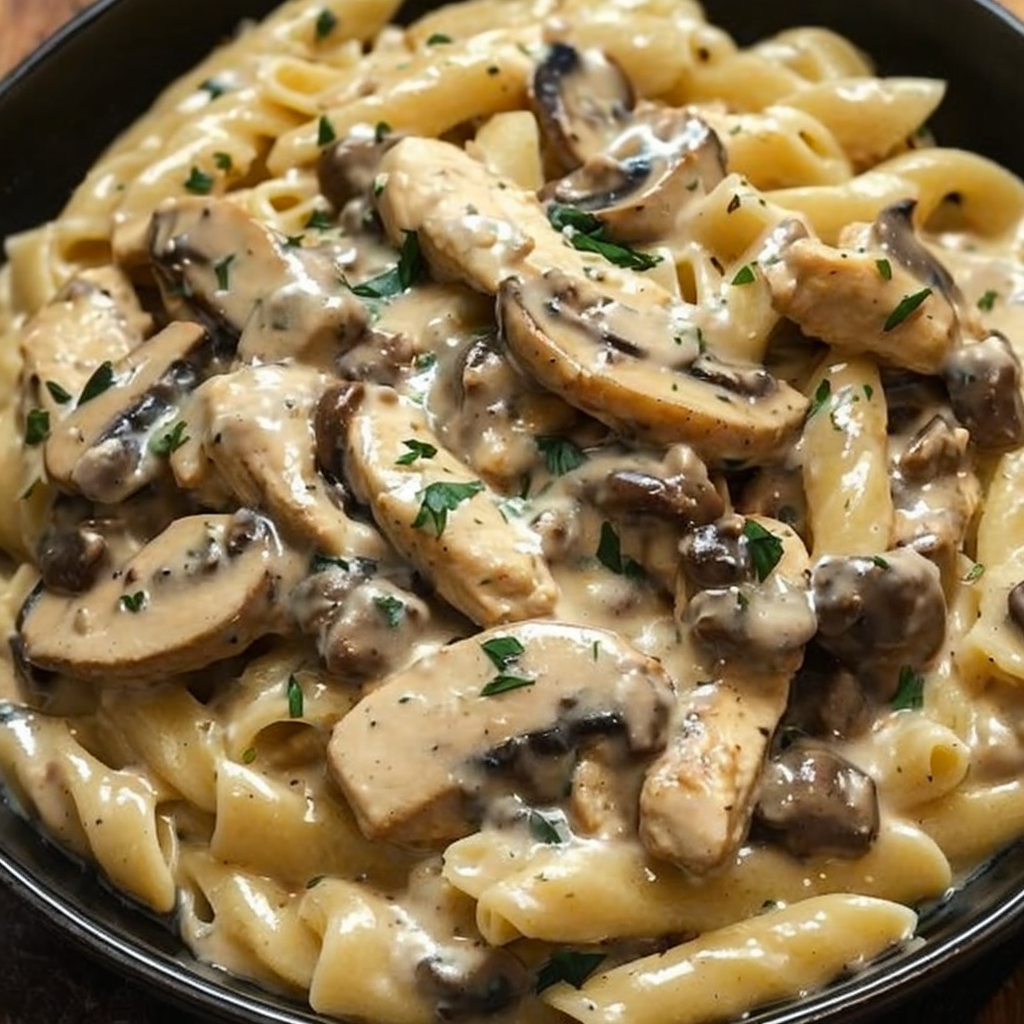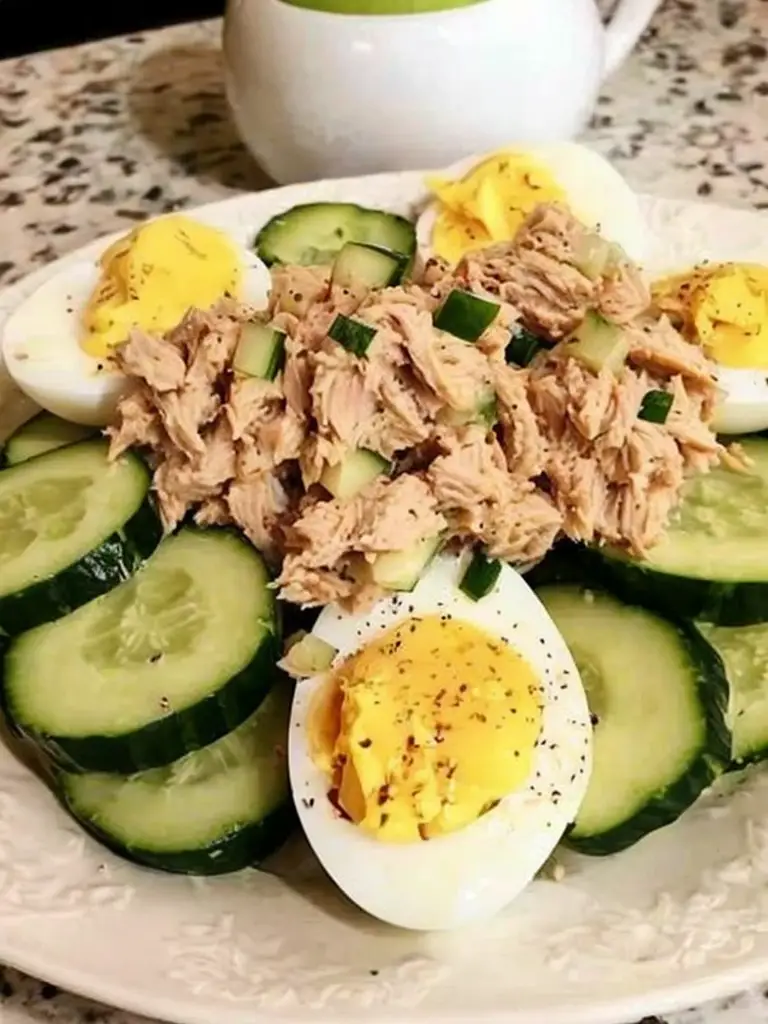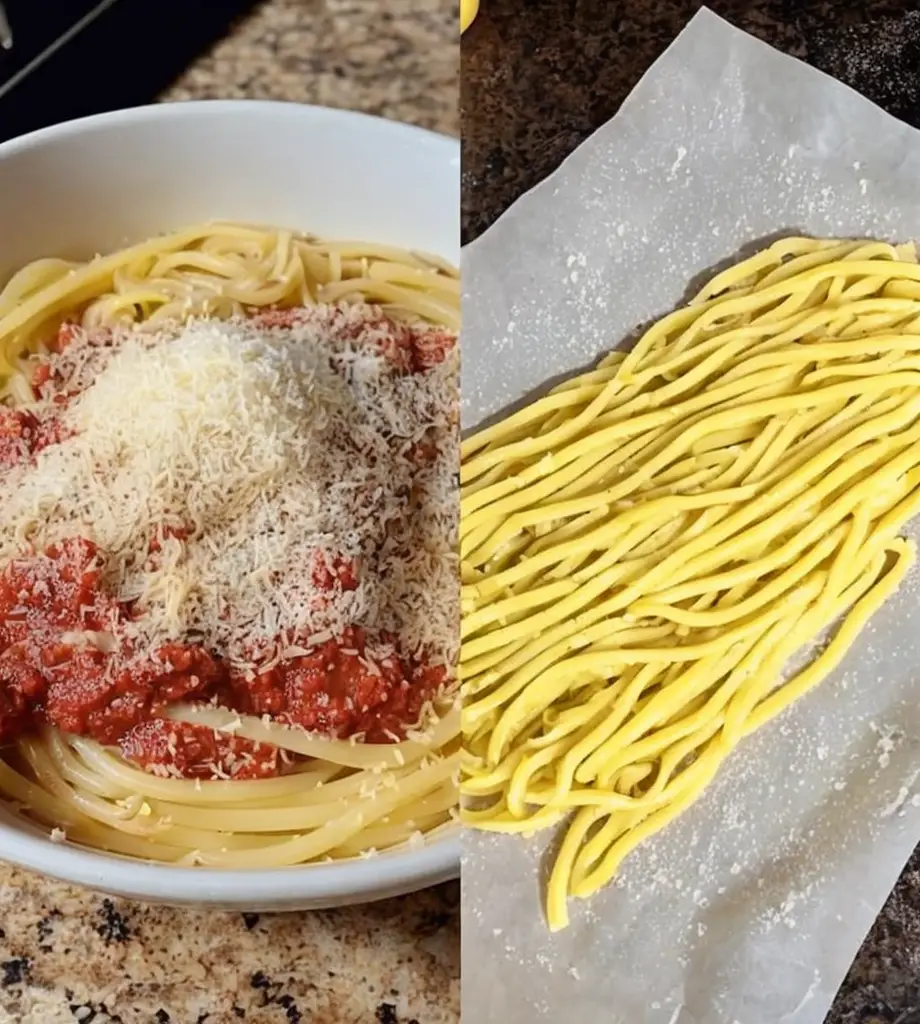Hearty Chicken and Mushroom Alfredo: The Creamy Comfort Dish You’ll Love
The Hearty Chicken and Mushroom Alfredo recipe is a comforting blend of savory chicken and earthy mushrooms enveloped in a rich and creamy Alfredo sauce. This dish brings together tender chicken breast, mushrooms, and fettuccine pasta, topped with freshly grated Parmesan cheese to create a harmonious balance of flavors. The elegance of the creamy sauce, combined with the umami notes from the mushrooms, transforms a simple weeknight dinner into something truly special.
Every bite of this dish offers a sensory experience: the sweetness of sautéed garlic, the luscious cream, and the gentle saltiness of cheese bind the ingredients together. It is not just a meal but an invitation to savor moments gathered around the table with family and friends. Whether for a casual dinner or a special occasion, this Hearty Chicken and Mushroom Alfredo promises to delight everyone’s palate.
Quick Recipe Highlights
- Flavor Profile: The dish presents a delightful blend of creamy textures and savory flavors, highlighted by the deep, rich notes of sautéed mushrooms.
- Texture: The fettuccine offers a smooth mouthfeel, perfectly complementing the tender chicken and the creamy sauce.
- Aroma: The fragrance of the garlic and freshly cooked mushrooms wafts through the kitchen, tantalizing anyone nearby.
- Visual Appeal: The creamy Alfredo sauce coats the pasta beautifully, garnished with a sprinkle of freshly chopped parsley for a pop of color.
- Skill Level Needed: While this recipe requires some basic cooking skills, it is achievable for home cooks looking to elevate their culinary game.
- Special Equipment: Basic kitchen tools such as a sauté pan, pot, and measuring cups will suffice for this delightful meal.
Recipe Overview
- Difficulty Level: This recipe is moderate in difficulty, requiring attention to detail during cooking to ensure the pasta is perfectly coated and the sauce reaches the ideal creamy consistency.
- Category: Enjoy this dish as a main course, perfect for lunch, dinner, or a hearty meal after a long day.
- Cuisine: Italian cuisine inspires this Hearty Chicken and Mushroom Alfredo, emphasizing creamy sauces and delightful pasta pairings.
- Cost: With an approximate total cost of about $15, this dish provides a great flavor-to-cost ratio for family dinners.
- Season: This creamy pasta dish shines throughout the year, especially during the colder months when comforting flavors are desired.
- Occasion: Ideal for dinner parties, family gatherings, or cozy nights in, it is versatile enough to suit any occasion.
Why You’ll Love This Recipe
This Hearty Chicken and Mushroom Alfredo shines with an irresistible combination of taste and texture. The creamy Alfredo sauce forms a velvety coating around the perfectly cooked fettuccine, while the tender chicken pieces and earthy mushrooms create a satisfying mouthfeel. As the chicken and mushrooms cook, they release juices that infuse the sauce, enhancing its flavor and creating a unified dish.
Convenience is another compelling reason to embrace this recipe. With a straightforward preparation and cooking process totaling around 45 minutes, dinner can be on the table with minimal effort. The ingredients are commonly found in most pantries, making this recipe not only accessible but appealing to whip up after a busy day.
From a nutritional standpoint, this dish balances carbohydrates from the pasta, protein from the chicken, and essential vitamins and minerals from the mushrooms. This makes it a wholesome option for those seeking a filling yet satisfying meal that offers energy and nourishment.
Socially, this chicken and mushroom Alfredo is perfect for sharing. Gather your loved ones around the table and watch as they savor every bite of this creamy delight, inviting conversations and laughter while indulging in warming flavors.
Moreover, its cost-effectiveness makes it a dish that won’t break the bank. With affordable ingredients combined to create a hearty meal, it is a fantastic choice for families or anyone seeking nourishment without compromising quality or taste.
Historical Background and Cultural Significance
The origins of Alfredo sauce date back to the early 20th century in Rome, Italy. Fine dining establishments popularized the dish due to its rich, creamy texture that delighted diners at the time. As Italian immigrants spread across countries, the Alfredo preparation gained popularity, particularly in the United States, where it became a staple in American Italian cuisine.
Culturally, the dish represents a fusion of creamy sauces and pasta that are hallmark features of Italian cooking. The Hearty Chicken and Mushroom Alfredo brings together a delightful ensemble of ingredients, often reminding people of family gatherings, celebrations, and comforting meals enjoyed during difficult days.
The evolution of the Alfredo recipe has seen various adaptations over the years. The traditional Alfredo, made with just butter and cheese, has expanded to include cream, chicken, and other proteins. The addition of mushrooms not only enhances the dish’s flavor but adds nutritional value and a more complex texture that elevates the classic recipe.
Regionally, variations of Alfredo can be found throughout Italy, often using local ingredients that highlight regional flavors. As families began to put their creative spin on the dish, the Hearty Chicken and Mushroom Alfredo showcases how food can adapt and evolve while maintaining its comforting essence.
Ingredient Deep Dive
Chicken
Chicken is the star of the dish, providing a hearty source of protein. Historically, chicken has been an integral part of Italian cuisine, frequently featured in pasta dishes. For optimal flavor, fresh, high-quality chicken breast is recommended. When selecting, look for a firm texture with no discoloration. Store in the refrigerator up to two days or freeze for longer shelf life. If chicken isn’t available, turkey makes a great substitute.
Mushrooms
Mushrooms add an earthy flavor, essential in enriching the dish’s taste profile. Known for their nutritional benefits, especially in terms of vitamins and antioxidants, mushrooms have a fascinating history in Mediterranean diets. When selecting, look for firm, plump specimens, and avoid any with wet spots. Store mushrooms in a paper bag in the refrigerator. They can easily be swapped with other varieties like cremini or shiitake if needed.
Fettuccine
Fettuccine is the traditional pasta choice for this dish, providing a broad surface area for sauce adherence. Originating from Italy, this pasta variety has gained popularity across the globe. Opt for dried or fresh fettuccine based on availability. Store pasta in a cool, dry place, and it has a long shelf life. If fettuccine isn’t desired, other pasta shapes like penne or rigatoni can be used for delightful adaptations.
Common Mistakes to Avoid
- Using the wrong pasta: Always choose pasta that can hold the sauce, like fettuccine. Short pasta could work, but the texture and flavor profile will differ.
- Overcooking the chicken: Cook chicken just until it’s no longer pink to keep it juicy. Overcooking makes it dry and less flavorful.
- Not seasoning adequately: Flavor develops through salt. Ensure you season each layer in the cooking process, from the chicken to the sauce.
- Rushing the sauce: Make sure to let your sauce simmer; this enhances the flavors and allows the ingredients to meld beautifully.
- Not using freshly grated cheese: Pre-packaged cheese often contains fillers and doesn’t melt as nicely. Freshly grated cheese ensures creaminess.
- Skipping the sauté step for mushrooms: Sautéing enhances mushrooms’ flavor and eliminates excess moisture, which could dilute your sauce.
- Adding cold dairy to hot pans: Always incorporate dairy gradually into hot sauces to avoid curdling.
- Not tasting as you go: The best dishes are adjusted along the way. Regular tasting helps achieve the perfect balance of flavors.
- Using low-quality ingredients: This dish relies heavily on its components; high-quality chicken and cheese can elevate the meal dramatically.
- Inadequate sauce-to-pasta ratio: Ensure a generous amount of sauce coats your pasta for the best experience. Adjust based on personal preferences.
Essential Techniques
Sautéing Chicken
Sautéing is crucial in developing a flavorful base for your dish. This technique involves cooking chicken over medium-high heat until golden brown. To master it, preheat your pan and avoid overcrowding, which can lead to steaming instead of browning. Look for a golden hue on the chicken before flipping to achieve that crispy texture.
Making Alfredo Sauce
Creating a creamy Alfredo sauce requires attentive simmering. After melting butter and adding cream, keep the mixture at a low simmer to prevent sticking or burning. Stir continuously to prevent clumping. The final product should be smooth, glossy, and thick enough to coat the back of a spoon.
Pro Tips for Perfect Hearty Chicken and Mushroom Alfredo
– Always use room temperature chicken for even cooking. This prevents the outer layers from cooking too quickly while the center remains undercooked.
– Use a combination of seasoned salt and fresh herbs during cooking to elevate the dish. Fresh parsley adds a bright note to the final product.
– Choose high-fat content cream for the sauce; this creates a richer and creamier texture.
– Don’t forget to reserve some pasta water to adjust the sauce’s consistency if it becomes too thick.
– Allow the sauce to rest for a few minutes off the heat; this will help thicken the mixture further.
– Garnish with toasted pine nuts or fresh herbs for an added crunch and visual appeal.
– Turn down the heat before adding cheese to avoid clumping. Stir slowly to ensure it integrates seamlessly.
– Serve immediately, as the pasta can absorb the sauce if left too long before serving.
Variations and Adaptations
The Hearty Chicken and Mushroom Alfredo can easily accommodate various regional variations. Adding sun-dried tomatoes or spinach can introduce vibrant colors and flavors, while Italian sausage can offer a spicy twist. For seasonal adaptations, consider roasted butternut squash in the fall for added sweetness and creaminess.
Dietary modifications also elevate this dish for various needs; for a gluten-free version, opt for rice or quinoa pasta. For those looking for lighter fare, replacing chicken with grilled vegetables can provide a satisfying, plant-based meal. Switching the heavy cream for a low-fat alternative can keep flavors intact while reducing calories.
Flavor variations are limitless. Consider infusing herbs like thyme or oregano into your sauce for an aromatic experience. Feel free to play with textures as well; adding crispy pancetta or breadcrumbs offers an enticing crunch that contrasts the creaminess of the dish.
Serving and Presentation Guide
For an elegant serving technique, twirl the fettuccine onto plates for a restaurant-style appearance. Drizzle additional sauce over each portion for a luscious finish, and sprinkle fresh parsley for color. Classic accompaniments can include garlic bread and a simple side salad to balance the meal. Serve everything hot, as the comforting warmth of the dish heightens the experience. Adjusting portion sizes can help cater to guests with varying appetites.
Incorporating elements such as small bowls of grated cheese on the side adds a personal touch to the dining experience and invites guests to customize their plates.
Wine and Beverage Pairing
When choosing a wine to pair with Hearty Chicken and Mushroom Alfredo, a Chardonnay stands out for its buttery texture and hints of fruit that complement the creaminess of the dish. Alternatively, a Pinot Grigio provides a crisp contrast that refreshes the palate. For non-alcoholic options, sparkling water infused with lemon can cleanse the palate, while iced tea offers a refreshing accompaniment.
If enjoying coffee with dessert afterwards, consider a light roast that offers floral notes alongside the following courses for a well-rounded end to the meal.
Storage and Shelf Life
To maintain freshness, store leftover Hearty Chicken and Mushroom Alfredo in an airtight container in the refrigerator. It can typically last 3-4 days, but always check for spoilage signs before consuming. If the texture becomes too thick upon reheating, add a splash of milk or cream to achieve the desired consistency.
For longer storage, this dish can be frozen for up to two months. It’s best to freeze without the pasta for optimal texture. When reheating, thaw in the refrigerator overnight and warm gently in a pan over low heat.
Make Ahead Strategies
This hearty dish can be prepped ahead to save time on busy nights. Cook the chicken, mushrooms, and sauce in advance, then store them separately in the refrigerator. The day you plan to serve, simply boil fresh pasta and combine everything over low heat for a quick assembly.
Quality can remain high with proper storage. However, adding fresh elements—like herbs—immediately before serving ensures that the dish retains its vibrancy and flavor richness.
Scaling Instructions
Adjusting the Hearty Chicken and Mushroom Alfredo recipe is simple. If you need to serve fewer people, halving the ingredients works seamlessly. Conversely, if needing to accommodate a larger group, doubling or tripling the recipe is straightforward; just make sure your cooking vessel can handle the increased volume.
Timing can vary with larger quantities as well. Allow extra time to ensure that everything cooks evenly. Store leftovers with care, and remember that additional servings might require a slightly longer reheating period.
Nutritional Deep Dive
Analyzing the nutritional aspects of Hearty Chicken and Mushroom Alfredo reveals its balanced macro composition. Each serving contains a rich source of protein from chicken, carbohydrates from pasta, and healthy fats from the cream. It’s an excellent choice for those seeking a hearty meal without compromising on nutrition.
Micronutrient analysis highlights essential vitamins and minerals provided by mushrooms and fresh herbs, offering health benefits that support immune functions and overall health. This dish can cater to various dietary considerations, ensuring it remains suitable for many lifestyles.
Portion control is also significant in this recipe, enabling diners to enjoy the delicious flavors while keeping an eye on their caloric intake. With adjustments to the recipe, such as reducing cream or pasta, it can also effectively fit into weight management strategies.
Dietary Adaptations
To make Hearty Chicken and Mushroom Alfredo suitable for different dietary needs, there are several adaptations available. For a gluten-free option, substituting traditional fettuccine with gluten-free pasta maintains the essence while accommodating dietary restrictions. For those who prefer a dairy-free version, using coconut milk or cashew cream can recreate the creamy texture without the dairy.
Vegan adaptations are easy as well by omitting chicken and replacing it with sautéed vegetables. Nutritional yeast can be incorporated for a cheesy flavor, while gluten-free pasta ensures the dish remains harmonious for all diners.
Explore low-carb options by using spiralized zucchini or cauliflower rice. For those pursuing a keto or paleo lifestyle, these swaps provide the same satisfying flavors and textures without excess carbs.
Troubleshooting Guide
If experiencing texture issues, such as the sauce being too thick or clumpy, this often results from cooking at too high a heat or incorporating dairy too quickly. To resolve this, return the sauce to low heat, stir in additional liquid slowly, and whisk until smooth.
Flavor balance can be adjusted by incorporating more seasoning gradually. Tasting throughout the cooking process will prevent over-salting and allow for precise adjustments. If the dish turns out bland, consider adding a squeeze of lemon juice for brightness.
Temperature problems often arise if the chicken isn’t cooked evenly or pastas become mushy. Ensuring even cooking by cutting chicken pieces uniformly can alleviate this problem. Pay close attention to boiling times for pasta to maintain texture.
Equipment challenges, such as working with non-stick pans, can affect cooking success. Investing in good quality cookware will prevent sticking and promote even cooking.
Recipe Success Stories
Many home cooks have shared their success stories utilizing this Hearty Chicken and Mushroom Alfredo recipe. From families coming together at dinner to individuals mastering their cooking skills, the positive feedback emphasizes the dish’s versatility. Adaptations by readers have led to unique variations, like adding seasonal vegetables.
Notably, readers found joy in the stunning visual presentation as they experimented with various garnishes. Suggestions like adding herbs or using personalized serving platters highlight how even simple dishes can be transformed into showstoppers for gatherings.
Photography tips also stemmed from those documenting their culinary journey. Lessons on capturing the essence of a well-plated meal have enriched the recipe’s community experience, inspiring more cooks to share their artistry.
Frequently Asked Questions
Q1: Can I use frozen chicken for this recipe?
A1: While it’s best to use fresh chicken for an optimal texture and flavor experience, you can use frozen chicken if necessary. Just ensure it’s fully thawed and cooked thoroughly to avoid any health risks.
Q2: What can I replace the mushrooms with?
A2: If you’re not a fan of mushrooms, consider adding spinach, asparagus, or bell peppers to the dish. Each provides unique flavors while maintaining the creamy essence of the Alfredo sauce.
Q3: Is it necessary to use heavy cream?
A3: While heavy cream gives the richest texture, you can substitute it with half-and-half or a dairy-free cream alternative. The sauce will be less rich but still delicious.
Q4: How do I store leftovers?
A4: Store leftovers in an airtight container in the refrigerator for up to 4 days. To reheat, use low heat, adding a splash of milk if the sauce is too thick.
Q5: Can I make this dish ahead of time?
A5: Yes! You can prepare the chicken, mushrooms, and Alfredo sauce a day ahead. Just cook the pasta fresh when you’re ready to serve for the best texture.
Q6: Is this recipe kid-friendly?
A6: Absolutely! The creamy sauce and tender chicken are appealing to kids. You can adjust flavors and spices to cater to their preferences.
Q7: What cheese is best for this Alfredo?
A7: Freshly grated Parmesan cheese is traditional for Alfredo sauce, but you can mix in a bit of Pecorino Romano for added depth and saltiness.
Q8: Can I freeze the Alfredo sauce?
A8: Yes! You can freeze Alfredo sauce for up to 2 months. Thaw and reheat gently on the stove, stirring frequently to avoid separation.
Q9: Is there a vegetarian option for this recipe?
A9: Yes! Replace the chicken with vegetables like zucchini, bell peppers, or eggplant, and use vegetable broth instead of chicken stock.
Q10: What is the best way to reheat leftovers?
A10: To reheat leftover Alfredo, use low heat in a pan, adding a splash of cream or milk to maintain creaminess. Stir frequently.
Additional Resources
If you’re interested in expanding your cooking repertoire, consider trying related recipes like Shrimp Scampi or Spinach and Ricotta Stuffed Shells. These recipes showcase similar flavors and cooking techniques. Additionally, explore technique guides focusing on mastering sauces, including variations of Alfredo.
For ingredient-specific information such as how to select quality chicken or the benefits of mushrooms, armed with knowledge will enhance your kitchen experience. Finally, consider investing in essential kitchen equipment like non-stick pans or high-quality knives to elevate your cooking.
Join the Conversation
We invite you to share your Hearty Chicken and Mushroom Alfredo experiences with us! Take stunning photos of your creations and share them on social media. Your unique variations and adaptations inspire others to experiment in the kitchen, fostering a community of culinary enthusiasts.
Engage in recipe reviews and let us know what worked and what could be improved, as your feedback is invaluable. Together, we can create a collection of wonderful stories surrounding this beloved dish, making it a shared experience for all.
The Recipe
Hearty Chicken and Mushroom Alfredo
Serves: 4 servings
Prep Time: 15 mins
Cook Time: 30 mins
Total Time: 45 mins
Kitchen Equipment Needed
- Large pot for pasta
- Sauté pan
- Measuring cups and spoons
- Wooden spoon or spatula
- Grater for cheese
- Colander for draining pasta
Ingredients
- 2 chicken breasts, diced
- 8 oz. fettuccine pasta
- 8 oz. fresh mushrooms, sliced
- 4 tbsp. butter
- 2 cups heavy cream
- 1 cup freshly grated Parmesan cheese
- 2 cloves garlic, minced
- Salt and pepper to taste
- Fresh parsley for garnish
Directions
- In a large pot, boil salted water and cook the fettuccine according to package instructions. Drain and set aside.
- In a sauté pan, melt butter over medium heat. Add garlic and sauté for 1 minute until fragrant.
- Add diced chicken to the pan and cook until golden brown and cooked through, about 5-7 minutes. Season with salt and pepper.
- Stir in the sliced mushrooms and cook for another 5 minutes, until they are tender.
- Pour in the heavy cream and bring to a simmer. Let it cook for 5-7 minutes until slightly thickened.
- Add grated Parmesan cheese to the sauce and stir until melted and creamy.
- Toss in the cooked fettuccine and mix until well coated with the sauce.
- Garnish with fresh parsley before serving.
Recipe Notes
- You can replace the chicken with shrimp or keep it entirely vegetarian by using just mushrooms and adding more vegetables.
- For a lighter version, substitute heavy cream with half-and-half or a dairy-free cream alternative.
- Feel free to experiment with different types of mushrooms to customize flavor profiles.




